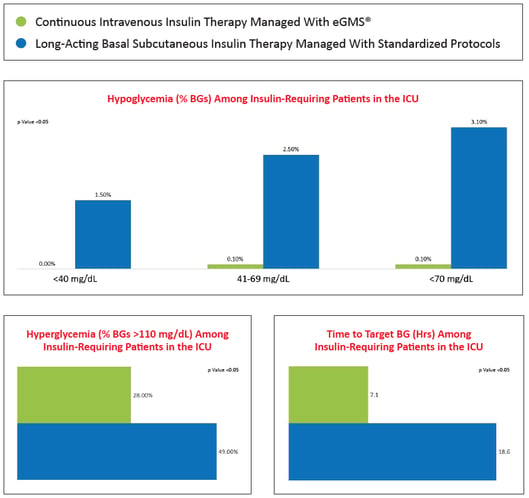Improved Patient Safety and Glycemic Outcomes in the ICU Using Computer-Guided Intravenous Insulin Therapy Versus Subcutaneous Insulin Therapy
Presentation
Diabetes Technology Society (DTS) Virtual Poster Meeting
Date
June 18, 2020
Authors
Marina Rabinovich, PharmD, BCPS, Alexandria Hall, PharmD, Rita Gayed, PharmD, BCCCP, Katleen Chester, PharmD, BCCCP, Jennifer Crowe, MHA, CPHQ, Jordan Messler, MD, SFHM, FACP
OBJECTIVE
Compare the safety and efficacy of continuous intravenous insulin therapy to long-acting basal subcutaneous insulin therapy in the ICU, specifically, the impact on rates of hypoglycemia and hyperglycemia as well as time to target blood glucose.
METHOD
Grady Hospital, a 640-bed academic medical center in Atlanta, Georgia, conducted an IRB-approved retrospective review of 200 adult patients > 18 years old admitted to an ICU (medical, surgical, burn, neuroscience or cardiovascular) between October 2016 and June 2019. Half of the patients (100) received continuous intravenous insulin therapy and half (100) received long-acting basal subcutaneous insulin therapy.
All patients included in the review received therapy for a minimum of 48 hours. Patients with diabetic ketoacidosis (DKA) were excluded. Continuous intravenous insulin therapy was managed using the computer-guided eGlycemic Management System® (eGMS®).* Subcutaneous insulin therapy was managed using standardized manual protocols. Patients who received both forms of therapy were grouped according to the therapy initially prescribed.
Primary endpoints compared among the two groups included percentages of blood glucose readings (BGs) <40 mg/dL, 41-69 mg/dL, <70 mg/dL and >180 mg/dL plus time to target blood glucose.
* eGlycemic Management System® is a registered trademark of Glytec, LLC on behalf of Aseko, Inc. All Rights Reserved.
RESULT
Rates of hypoglycemia and hyperglycemia were significantly lower among patients who received continuous intravenous insulin therapy managed using eGMS® versus long-acting subcutaneous basal insulin therapy managed using standardized manual protocols. Likewise, time to target blood glucose was comparatively faster.
CONCLUSIONS
In the ICU, safety and efficacy of intravenous insulin therapy managed using eGMS® is superior to long-acting basal subcutaneous insulin therapy managed using standardized manual protocols, with lower rates of hypoglycemia and hyperglycemia and faster times to target blood glucose.
References
- Rabinovich M, Hall A, Gayed R, Chester K, Crowe J, Messler J. Improved Patient Safety and Glycemic Outcomes in the ICU Using Computer-Guided Intravenous Insulin Therapy Versus Subcutaneous Insulin Therapy. DTS Virtual Poster Meeting. June 18, 2020.
ECO #0845-A


